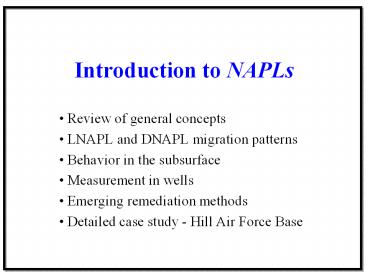Introduction to NAPLs PowerPoint PPT Presentation
Title: Introduction to NAPLs
1
Introduction to NAPLs
- Review of general concepts
- LNAPL and DNAPL migration patterns
- Behavior in the subsurface
- Measurement in wells
- Emerging remediation methods
- Detailed case study - Hill Air Force Base
2
What are NAPLs ?
- Immiscible hydrocarbons in the subsurface which
can partially dissolve into water at very slow
rates - Can be either lighter than water (LNAPL) or
denser than water (DNAPL) - Form a visible, separate oily phase in the
subsurface - Complex migration governed by gravity, buoyancy,
and capillary forces, and soil texture
3
Phase Distribution
- Free phase, aqueous, gaseous, and solid
- Distribution dictated by four processes
- Volatilization (Henrys Law)
- Dissolution (solubility)
- Sorption (tailing effects in pump/treat systems)
- Biodegradation (aqueous phase mostly)
4
LNAPL Transport Properties
- Density (LNAPL vs DNAPL)
- Viscosity (governs mobility in subsurface)
- Interfacial tension (pore scale effect)
- Wettability (affinity of soil for fluids)
- Capillary pressure (pressure across an interface)
- Saturation (fraction of pore space containing
fluid) - Relative permeability (function of saturation)
5
Mobile vs. Residual NAPL
Mobile Phase NAPL or (Free-Phase NAPL) is a
continuous mass of NAPLthat can flow under a
hydraulic gradient
Residual Phase NAPL is trapped in the pore spaces
between the soil particles, and cannot be easily
moved hydraulically
6
Long-Term Sources
- Total mass of NAPL at a site is often many times
the total dissolved mass at the same site - The EPA in 1989 and 1992 concluded that poor
performance of pump-and-treat systems was due to
NAPLs acting as a continuing source - One kg of NAPL can contaminate
- 100,000 L of groundwater at 10 mg/L, or
- 100,000,000 L of groundwater at 10 µg/L
- It can take many years to dissolve a large NAPL
source
7
Smearing of LNAPL
- Seasonal fluctuation of water table
- Pump and treat system with large drawdowns -
causes serious problem if wells fail and water
level increases - Trapping of LNAPL below the water table
- Trapping of LNAPL on clay lens as water table
declines
8
LNAPL Release to Vadose Zone
9
LNAPL at the Water Table
10
DNAPL below the Water Table
11
Wettability
- Capillary pressure proportional to interfacial
tension and inverse to radius of curvature - Fluid drawn into pore is the wetting fluid
- Fluid repelled by capillary forces is the
non-wetting fluid - Water is almost always wetting when mixed with
air or NAPLs in the subsurface - NAPL is generally the wetting fluid in air but
non-wetting fluid in water
12
Wetting Relationships
NAPL is Non wetting fluid
13
NAPL migration in primary vs. secondary porosity.
- (A) NAPL migration through primary porosity.
- (B) NAPL migration through secondary porosity
features - (fractures, root holes, etc.).
A
B
14
LNAPL Moving Upgradient
15
Fractured Rock System
16
Composite DNAPL Site
17
Dissolving NAPL
18
Relative Permeability
19
Flow Regimes
20
Hydraulic Mobilization of NAPL
21
Calculating Saturation
Can be estimated in the lab via the
following Where rb soil bulk density
g/cm3 rn NAPL bulk densityg/cm3 n
porosity TPH Total Petroleum
Hydrocarbons mgNAPL/kgdry soil
22
Partitioning Tracer Test for SN
- Chemicals are introduced consisting of
conservative and partitioning tracers (PTT) - NAPL - Water Partition Coefficient KN.
- KN CN/Cw where CN is the conc. in NAPL and Cw
is water conc. - At steady state, the effect is to delay or retard
the PT transport rate according to a retardation
factor - R 1 (KN SN)/(1 - SN) tp/tn
23
Partitioning Tracer Test for SN
- Tp is travel time for the Partitioning tracer
- Tn is the travel time for the conservative tracer
(Br-) - Sorption is assumed insignificant
- PT compounds often used include alcohols such as
- ethanol (0.1) KN values in parentheses
- n-pentanol (1.4)
- n-hexanol (4.6)
- 2,2 dimethyl-3-pentanol (12.9)
- n-heptanol (20.0)
24
Typical Values of SN
- EW1 from UF test cell 0.031
- EW2 from UF test cell 0.049
- EW3 from UF test cell 0.088
- Total or Avg for UF cell 0.054 or about 5.4
NAPL Saturation
25
Partitioning Tracer Test for SN
- Measured BTC for PTT with bromide
- Time difference between different chemicals
allows calculation of SN
Bromide n-pentanol 2,2 DMP
C/C0
Effluent Volume (L)
500 1000 1500 2000
26
Apparent LNAPL Thickness
27
Apparent LNAPL Thickness
- Thickness in screened well casing only indicator
of actual thickness in the unit - Thickness in the well may be 2 to 10 times larger
than actual thickness of mobile LNAPL in the
surrounding aquifer - No methods exist to improve these estimates
28
DNAPL Detection Problems
29
Remediation of LNAPL
- Excavation
- Trenches, drains, and wells
- Soil vapor extraction (SVE)
- Air sparging
- Enhanced oil recovery (water, steam, cosolvents,
surfactants, etc) - Bioremediation
- Physical barriers
30
Hill AFB in Utah Largest Remediation Project for
NAPL in a Source Zone - Joint project with
several universities, U.S. EPA, U.S. Air Force,
and private industry1994 - 1998

